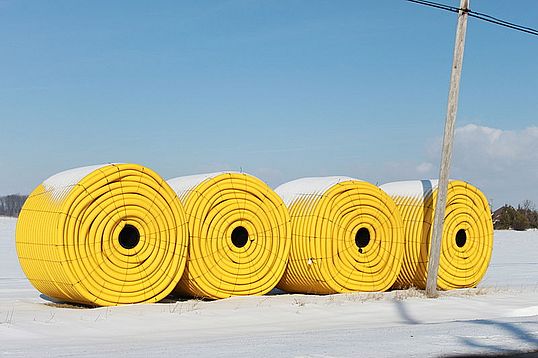Agricultural Tile Drains - Beneficial or Costly?
December 2013

If you walk along a stream in an agricultural area it is not unusual to encounter pipes discharging water directly into it. These pipes are attached to drain systems that farmers use to lower the water table for their fields. The practice, termed tile draining, can dramatically improve crop yields on marginal fields, but its environmental impact is unclear.
Fields have been tiled for millennia. The Roman statesman Cato was the first to describe the practice around ancient Rome. He noted the use of brush, straw, poles, stones, boards, and tile to improve drainage in fields. It was popularized in the United States in the mid 1800s by John Johnston, a Scottish immigrant who used tile drainage to improve the poor soils of his farm in upstate New York. Today perforated plastic piping has largely replaced actual ceramic tiles in fields.
Pipes are placed in trenches two to four feet below the surface. Groundwater flows through the pipes rather than the soil, because the pipes offer a pathway of least resistance. As a result, the groundwater table is lowered to the depth of the pipes thus ensuring that a crop’s roots won’t become water logged, and that fields drain earlier in the spring. The pipes are usually oriented to discharge into a nearby stream, though in some cases, the discharge may just be to an area lower in elevation.
Initially, research on tile drainage in the Champlain Basin focused on economic issues, but that has changed. At first researchers sought means to improve the efficiency of tiling and maximize yields while minimizing the cost of installation. Tiling was seen as a way to increase the social and economic well-being of the region. Today, that has shifted and more researchers are exploring the affects of tiling on the ecosystem and nutrient loading to our waters.
There is no question that the water discharged to streams via tiles carries nutrients which contribute to algae blooms. Tile drains increase the discharge of nitrogen, which moves quickly through groundwater. However, nitrogen is usually considered secondary to phosphorus in promoting Lake Champlain algae blooms. Unlike nitrogen, phosphorus is not mobile in groundwater. Instead, most of it attaches to soil particles. On the other hand, dissolved phosphorus, which is more easily taken up by algae than sediment-bound phosphorus, can be found in tile drainage.
It is not clear however, whether tiling leads to an increase in phosphorus discharge. Most of the phosphorus that leaves fields does so overland during spring snowmelt. Diverting overland flow to tiles allows phosphorus-laden water to percolate through the soil. On the way to the tiles it can become attached to soil particles.
Unfortunately, not all the phosphorus that reaches tile drains gets filtered by the soil. Heavy clay soils, common in the Champlain Valley, often develop wide cracks when the sun dries them. These cracks provide preferential flow paths for water and phosphorus, delivering more to the drains with less being filtered by contact with soil particles. Thus tile drains in areas where soil cracking is common have a greater impact on water quality than drains in soils where cracking does not occur.
In addition to nutrients, tiling changes the overall hydrology of the landscape. Historically, tiling has been used to drain wetlands, reducing the water storage capacity of the land. Water reaches stream courses more quickly from tiled fields, potentially exacerbating flooding and erosive stream flows.
There are best management practices that can be applied in tile drained fields. Seasonally blocking drains promotes runoff during the winter but stores water and thus nutrients during the summer. Wetlands or bioreactors can be constructed at tile discharge points. Bioreactors are essentially mini-wetlands consisting of a storage area filled with a media like wood chips or charcoal. The media binds nutrients while allowing water passage. Bioreactors tend to be more successful at removing nitrogen than phosphorus. Research is currently on-going to identify and evaluate other such practices.
Tile drains clearly can provide benefits to farmers. In certain situations, such as in soils that tend to crack, they also can contribute to water quality problems. Moving forward it's critical to identify management practices and strategies that offset any problems tile drainage might cause.
Lake Look is a monthly natural history column produced by the Lake Champlain Committee (LCC). Formed in 1963, LCC is the only bi-state organization solely dedicated to protecting Lake Champlain’s health and accessibility. LCC uses science-based advocacy, education, and collaborative action to protect and restore water quality, safeguard natural habitats, foster stewardship, and ensure recreational access.
Get involved by joining LCC using our website secure form (at www.lakechamplaincommittee.org), or mail your contribution (Lake Champlain Committee, 208 Flynn Avenue - BLDG 3 - STUDIO 3-F, Burlington, VT 05401), or contact us at (802) 658-1414, or lcc@lakechamplaincommittee.org for more information.